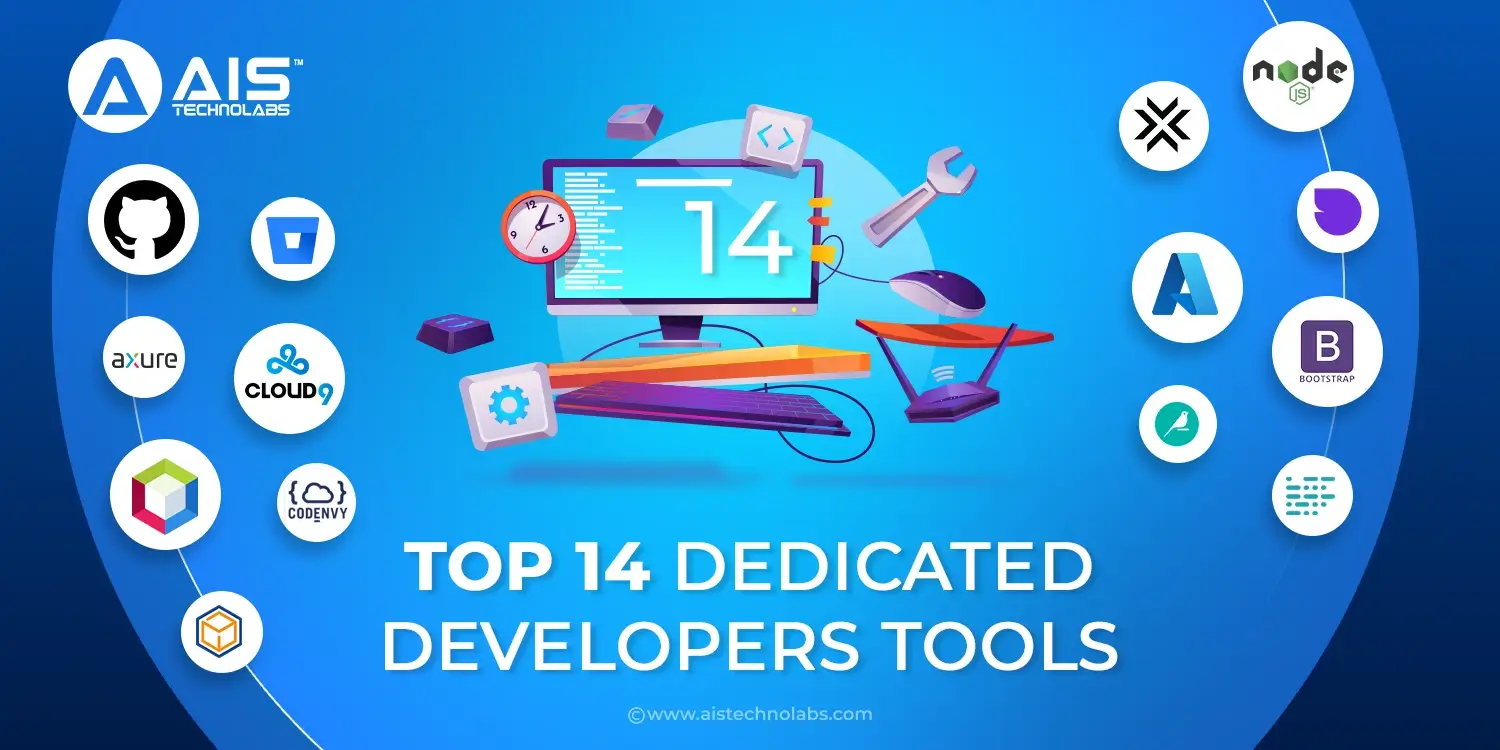Software development has been essential to the success of organizations and the ease of people's lives in this technological generation. Software development is now one of the rapidly expanding sectors. The use of software and applications has grown more significantly than ever in the modern era.
So what tools do dedicated developers need to create helpful software that achieves its goals? A package of ideal specialized software development tools updated with the best technological breakthroughs and integrations. In today's blog, we have listed top 14 dedicated developers' tools to look for in 2023.
1. GitHub
Millions of developers worldwide create and maintain their software on GitHub, the most sophisticated and significant development platform (mainly a version control system). GitHub is used to develop and maintain apps by over 65 million people and 3 million companies.
GitHub Key Features:
- The iteration support feature prevents errors and repetition.
- Command Palette provides advanced search, automation, and command-running capabilities.
- To coordinate the code review, project management solutions are available.
- Simple documentation for all software project kinds.
- Available with support for Markdown.
2. Azure
With the ability to create, distribute, and administer online applications, Azure is a powerhouse for software developers. Because Azure offers broad support for various programming languages, operating systems, and frameworks, dedicated developers want to utilize it as their primary tool.
It enables you to recognize and get rid of dangers so that you may create a fantastic project. Azure can also be a good place to learn fundamental software development principles.
Azure Key Features:
- It supports all programming languages which developers prefer to employ when doing development work.
- Its SDK collection includes a number of useful tools, including Vs. Code, Visual Studio, and Eclipse.
- You can build, distribute, and manage software or apps with one tool.
- Easily incorporates Microsoft BI.
3. AWS Cloud9
When it first debuted in 2010, Cloud 9 was an open-source, cloud-based IDE that supported many programming languages, including C, Python, JavaScript, and others. However, Cloud 9 was acquired by AWS in 2016 and enhanced to become a superior software development tool. After that, using it became a paid activity.
AWS Cloud9 Key Features:
- It enables developers to work on the same codebase concurrently, making real-time collaboration seamless.
- Automatic code completion makes it simpler for developers to create code fast and effectively. The Cloud 9 IDE enables auto-complete for several programming languages.
- Integral debugging: The Cloud 9 IDE has an integrated debugger that simplifies locating and correcting code issues.
- Cross-platform compatibility: The Cloud 9 IDE is compatible with Windows, Mac, and Linux. Because of this, developers may easily undertake assignments from any location.
4. DBSchema
DBSchema is a web-based database design tool. You may create, edit, and query your database designs with it. DBSchema is a database design tool that works with MySQL, PostgreSQL, SQLite, MariaDB, and MongoDB. With this tool, you may share the schema with other databases.
DBSchema Key Features:
- Even if you only have a little SQL familiarity, the "Query Builder" function lets you design database queries visually.
- Database administrators and software developers can create test data using the "Random Data Generator" tool.
- Compare multiple iterations of the migration script generation structure.
- You can create interactive charts, tables, and report sheets with "Report Designer."
5. Linx
Linx is a low-code software development tool. You can use it to develop and automate web services and back-end applications. Linx provides a user-friendly drag-and-drop interface and supports APIs, integrations, and automation without coding, frameworks, or infrastructure.
Linx Key Features:
- Simple features for managing and sharing documents.
- Includes built-in notifications.
- For creating mobile and website applications, built-in plugins are already available.
- Web development automation with low-code software, especially for the back end.
- You can automate and integrate the database, external systems, and functions by utilizing the drag-and-drop UI.
6. Codenvy
Codenvy is a cloud-based development environment that enables dedicated developers to collaborate with code seamlessly. It has functions like code review, collaboration, and debugging. For software developers, it offers both on-premises and cloud deployment options. Codenvy works with GitHub and Bitbucket, which are some of the cloud-based platforms.
Codenvy Key Features:
- You can gain comments on your code, share it with others, and merge changes made by other developers using Codenvy.
- You may create command-line installers using Codenvy to distribute files in any environment.
- Several operating systems, including Linux, Windows, macOS, Solaris, etc., are compatible with Codenvy.
- With this dedicated developers' tool, you can easily perform deployment configuration.
7. Bootstrap
A well-liked open-source web development framework for building responsive websites is called Bootstrap. It offers a collection of reusable JavaScript, HTML, and CSS elements that you can use to create websites quickly.
With Bootstrap’s responsive design, you can be assured of a professional look for your website. The responsive support will allow a similar design for any phone, desktop, or tablet. There will be no change in the UI of your website for any screen size.
Bootstrap Key Features:
- It facilitates consistency if multiple users are contributing to a similar project.
- It contains pre-written code blocks to speed up development.
- Features drag and drop functionality.
- Includes a long list of components.
- Strong JavaScript plugins are readily available.
8. Embold
A software development tool called Embold analyses source code and identifies different flaws that impact a project's security, resilience, stability, and maintainability. You can perform comprehensive software analytics using this tool's plethora of integrated plugins. A feature that detects anti-patterns aids users in avoiding the synthesis of unmaintainable code.
Embold Key Features:
- A number of other tools, including GitHub, Azure, BitBucket, etc., are effortlessly integrated with Embold.
- Git and plugins for IntelliJ IDEA and Eclipse are integrated. You’ll get language assessment options for around 10 varying languages.
- Software testing-friendly tool for software analysis and defect discovery.
- There are several plugins to improve functionality.
9. NetBeans
Netbeans is an Integrated Development Environment (IDE) that developers can use to develop Java and PHP applications. You’ll get various options and tools, including refactoring, code completion, and a debugger.
These features simplify the entire process of Java development. NetBeans also efficiently integrates with Maven and Ant.
NetBeans Key Features:
- Since NetBeans is a cross-platform hybrid development tool, it works efficiently with different OS like macOS, Linux, Windows, and Solaris.
- NetBeans has grown in popularity among developers thanks to its smart code editing, simple management procedure, writing bug-free and error-free code, and speedy user interface development features.
10. Dataiku DSS
If you’re looking for a comprehensive data science software tool, then Dataiku DSS is the one. A robust platform like Dataiku DSS makes it simple for companies to create and use machine learning models. Businesses may easily and quickly build data products with their user-friendly interface and many capabilities.
Dataiku DSS Key Features:
- You can explore and view your data in new ways with Dataiku DSS. Developers can easily determine the spot patterns along with the trends.
- Developers can easily prepare the data for analytic purpose.This entails preparing the data in the correct format by cleaning and formatting it.
- Also, Dataiku offers many tools for carrying out machine learning operations. You can use this to create models and algorithms to forecast upcoming occurrences or trends.
11. BitBucket
For software development projects utilizing the Git revision control system, Bitbucket is among the top web-based hosting options. Thanks to its business plans and free accounts, users can use repositories to collaborate with others. Dedicated developers mainly use this tool to manage and keep a track of all the updates in their source code.
BitBucket Key Features:
- Users can set up many repositories within the project to focus on their finished product or activity.
- Developers will get a repository for development and saving their source code with this web-based system.
- Strong teamwork with an infinite number of private repositories.
- Capable of allowing repository structure and supporting various services.
12. Axure
Axure is one of the popular prototyping tools. It’s used by business analysts, IT consultants, and product managers. Dedicated developers can create documentation, functional prototypes as well as wireframes.
Interactive prototypes of the concepts can be created, tested, and shared by designers and developers.
Axure Key Features:
- To generate UX prototypes, Axure combines a variety of event triggers, actions, and conditional logic.
- RP widgets can create functioning forms, dynamic interfaces, and grids.
- Without the need for coding expertise, consumers can now generate practical and accurate UX prototypes with Axure.
- It facilitates tools for creating wireframes and functioning prototypes with supporting documentation.
- It offers tools for low-code UX prototyping.
13. SendBird
An application program interface (API) for messaging, chatting, and websites is called SendBird. With offline messaging, translating, delivery receipts, statistics, and moderating capabilities, it is a fully controlled and well-organized chat platform that creates cutting-edge messaging experiences.
SendBird Key Features:
- Cutting-edge messaging API.
- Chat rooms and chatbots are supported with lag-free in-app audio and video calls.
- Chat rooms that may be customized allow organizations to designate chat rooms for particular clients or objectives. This makes it possible for a more tailored consumer experience.
- Messages can be delivered automatically to the target audience depending on the prefixed conditions the developer can configure.
14. Node.js
A runtime environment and library called Node.js allow JavaScript programs to run outside a web browser. Applications created in Node.js are intended to benefit from JavaScript's asynchronous nature by running several tasks simultaneously and gracefully resolving mistakes.
Node.js Key Features:
- It can manage numerous connections at once without stopping.
- You can use 3rd party and external modules to add extra functionality.
- Many Node.js modules provide systematic and speedy answers for creating and integrating the back-end structure of applications and integrating it with the front-end platforms.
Conclusion
The above software development tools are presented according to their categories and are rich in features and reliable. As a developer, you should carefully select a tool that aligns with your business and development needs. You can also seek assistance from AIS Technolabs and hire dedicated developers who can assist you in choosing the best-fit tool and make your development journey seamless.
FAQs
Q 1. Which are the ideal tools for software development?
Ans. The definition of an ideal tool depends upon each developer's requirements and individual choice. Nevertheless, Java, Ruby, and Python are some of the more well-liked software development tools.
Q 2. Does the framework function as a tool?
Ans. Although they are not tools, frameworks are frequently confused for them.
Q 3. Which web development trends should developers look out for in 2023?
Ans. In 2023, AI, ML, responsive design, dark mode stabilization, and cybersecurity will be very much in trend.
Q 4. What will be the newest breakthrough in software development?
Ans. The future of software development is in progressive web apps. They combine a website's capabilities and security with a mobile app's ease and responsiveness to provide the best of both worlds.






